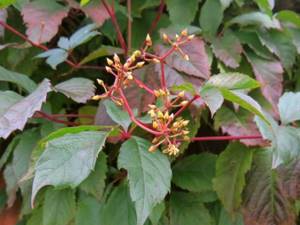Every owner of a country house, cottage or small rural house wants to decorate the site. But often this is necessary not only to improve the appearance of the site, but also to hide some buildings that do not have a very respectable appearance. Most often such buildings are: a barn, a veranda, an old gazebo, a summer kitchen. When such a need arises, few people think that in this case the best option is to plant girlish grapes, which can decorate any building. This inconspicuous plant, at first glance, has exceptional decorative effects.
Maiden grape vines
Maiden grape or virgin ivy is a vine that can grow up to 30 meters in length. Ivy feels great in our latitudes - it takes root well and does not require special care. A lushly growing plant with beautiful carved leaves can effectively decorate even the most inconspicuous courtyard buildings and enliven any corner of the garden and yard. Indoor varieties of virgin ivy are often used for landscaping industrial premises, school classrooms, and kindergartens.
This article will contain information about virgin grapes, planting and caring for which will not seem too difficult even to novice amateur gardeners.
Botanical description and varieties
This ornamental plant has a botanical name - Parthenocissus, which is translated from Latin as “virgin ivy”. The liana belongs to the Vinogradov family and has a second name - “maiden grapes”.
There are 19 plant species in the genus Parthenocissus. In open ground conditions, only two varieties are grown in Russia: Tripointed (Parthenocissustricuspidata) and Five-leafed (Parthenocissusguinguefolia) grapes.
Tripointed girlish grapes, the care and planting of which will be described below, is a vine on which there are three palmate leaves. The plant is attached to the support with special tendrils, of which there can be up to 10 pieces at the ends of the shoots. These tendrils have peculiar suction cups that allow them to be firmly attached to the support so that you are more likely to break the shoot than to tear off these fastenings. Shoots can reach a height of 10 meters or more. This variety does not tolerate frost well, which cannot be said about the next species.
The five-leaf virgin grape (care and planting of the plant will be described in the following sections) is in many ways similar to its predecessor, however, there are also significant differences, for example, leaves. They have an oval shape, pointed at the end. To grow this crop, you will need a lot of support, since the vine can grow above 18 meters in height during normal development. Just as in the previous case, all shoots are attached to the support using long tendrils with suction cups. The flowering period occurs at the end of summer, however, its fruits are not edible. With the onset of autumn, the foliage turns purple, which will give any garden area an unusually beautiful look. The variety tolerates even the most severe frosts.
What other varieties are grown outside our country? Here are just a few of them:
- Henry - perfect for indoor breeding. For planting it is necessary to use very deep containers. Fits well in bonsai.
- Attached - in most cases grown as a regular houseplant. Quite unpretentious in care.
- Engelman - has rather small leaves that lie very tightly together. The fastest growing variety of virgin grapes.
- Hairy - all the leaves of this plant are downward, as are the young shoots themselves. Does not tolerate cold winters well.
- Vichi is one of the most popular varieties, which is grown mainly in Europe. It has excellent decorative qualities and is quite easy to care for.

It is worth noting that these varieties are not suitable for cultivation in the climatic conditions of our country. Although virgin grapes are a rather unpretentious crop, they require compliance with certain care rules that cannot be implemented in Russia.
Landing in a permanent place
Virginia grapes take root both in autumn and spring. Some gardeners believe that it is enough to stick in cuttings, water them with water, and the plant will grow on its own. But this matter has its own subtleties.
Selecting a location
When choosing a location, take into account the fact that the girl’s grapes grow and cover all the supports that are encountered on its way: tree trunks, walls and chimney pipes. Therefore, you need to carefully read the information on the bag of seeds: on it, the manufacturer gives advice on choosing a location for each variety.
Recommendations:
- On the eastern and southern sides of the site, the plant is covered with large foliage.
- In the shade, grape leaves grow small and dark. Therefore, it is better to plant the plant in a lit area.
- Maiden grapes are an unpretentious crop; they grow on saline soils, but become capricious on depleted and dry soils.
- The presence of a vertical support along which long vines spread is the main condition for obtaining a beautiful plant.
Soil preparation
Seeds are planted in loose and fertilized soil. Young shoots become weak if there is a lack of nutrients, so the soil needs to be prepared before planting.
Instructions:
- A week before sowing, the weed is removed from the selected area.
- Dig a hole measuring 50 x 60 cm.
- The excavated soil is mixed with compost and sand in a ratio of 2:2:1.
- A drainage 20 cm high is constructed from expanded clay, pieces of slate or broken brick.
- Boards are placed on top of it and 350 g of double superphosphate or a liter jar of ash is poured.
- Fill in the prepared soil mixture.
Reproduction by cuttings and layering
Planting work is carried out in spring or autumn. For this, cuttings 7 mm thick with five buds are used.
Procedure:
- Prepare an irrigation hole.
- The lower part of the cutting is scratched so that it takes root faster.
- The seedling is placed in a hole and two buds are left on the surface.
- Make a support or tie a wire.
- Spill the soil thoroughly.
- To protect from the scorching sun, the bed is covered with geotextiles.
Those who have an adult bush of maiden grapes growing on their site can use the method of rooting vines and obtaining layering. In this case, one bud is left above the surface of the ground, the other is buried. Strong shoots grow close to the mother plant, and those located closer to the end of the vine are weak, as they lack nutrition.
Instructions:
- With the onset of spring, vines of two and three years old are selected.
- They are bent to the ground with waves and secured with pins.
- In places of contact with the ground, sprinkle with soil.
- Provide abundant watering.
A year later, the root system of the cuttings becomes strong and they are transplanted to a permanent place.
Preparation of seed material
The fruits become ripe from late August to mid-September. It depends on the region. Grape clusters are cut with ripe berries, otherwise the seeds in them will be unsuitable for planting.
To obtain seeds:
- Ripe berries are kept at room conditions for three weeks.
- After this, the seeds are removed, washed and dried.
Seed material is stored in paper bags
In this case, it is important to create conditions close to natural: average humidity and moderate temperature. In this way, the seeds remain viable until spring.
Before planting, the seeds are stratified. It can be carried out in natural and home conditions. In the first case, the seeds are planted in the ground in the fall to harden for three months. In the second case - in the spring, 7 weeks before sowing.
Instructions:
- Prepare containers and sand (perlite or vermiculite).
- The containers are filled with sand and spilled.
- Plant the seeds and cover with film.
- The container is stored in a cold room or refrigerator.
Planting a plant
Have you thought about how to plant girlish grapes or have you decided to plant this crop on your site for the first time? The plant is quite unpretentious, so you should not have any difficulties during planting.
Maiden grapes do not like very fertile soils, however, completely depleted areas will not be the best choice. You should also choose a place that has slight soil salinity. The crop is undemanding in terms of lighting, so this factor can be completely ignored when choosing a site for planting. It will feel great both in the shade and in the open sun. However, it is worth noting that planting a plant in shady places affects the color of its foliage in the autumn season - it will remain green almost until frost, while in the sun it could turn yellow or burgundy. Also, the vine may not bloom in the shade and, accordingly, may not form picturesque clusters with dark-colored berries.
The liana takes root equally well in both autumn and spring, so planting time does not play a special role. According to experienced gardeners, this crop is so easy to care for that you just need to plant it in a hole and water it with water. After this, the grapes will begin to grow on their own. You just need to have time to trim off the excess growth.
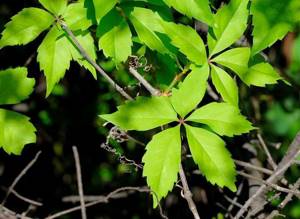
About a week before planting, it is recommended to cultivate and prepare the soil for planting. To do this, we remove all weeds from the site, and then dig special holes measuring 60 by 50 centimeters. The excavated soil must be mixed with a bucket of sand and a bucket of compost, then pour 300-400 grams of double superphosphate or a liter jar of ash into the bottom of the hole. After this, we arrange drainage: we place expanded clay, broken brick, crushed stone on the bottom - whatever comes to hand. Then we lay pieces of slate or planks on top so that the drainage layer does not get covered with earth so quickly. Pour some of the prepared substrate there. After the irrigation hole is formed, it will need to be mulched. For this purpose, you can use peat or dry leaves. Remember that the distance between neighboring seedlings must be at least one meter. After planting, be sure to water the plants.
Care and planting of virgin grapes, photos of which are given in the article, should only take place in open ground conditions. If a gardener plans to grow a perennial ground cover of grapes over a large area over time, it is recommended to maintain a distance of 0.6 meters between neighboring plants. From two to four vines are planted in each hole.
While the plant is small in size, it is necessary to install a reliable support near it that could withstand the weight of the vine in the future. As they grow, young branches need to be constantly directed in the right direction and tied up with fabric ropes. Remember that a mature plant will require quite high support. So it is recommended to take care of this in advance, especially if you are planting virgin grapes for many years to come. After all, the plant grows and occupies an ever larger area.
As for transplanting virgin grapes, this procedure must be carried out at the end of summer or early autumn so that the plant has time to acclimatize to the new place. The process itself is practically no different from the planting process. We dig up the old plant along with its roots and transplant it to a new “place of residence,” not forgetting to add fertilizer to the hole and lay a drainage layer.
Climbing - "Curly" vines
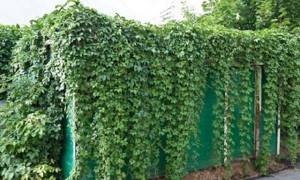
Grapes have long been popular among painters, and architects decorated buildings with them. Climbing grapes are an absolute long-liver; this variety can survive in favorable conditions for at least a century.
And even harsh conditions will be favorable for it: the species is not picky about soil, summer and winter temperatures.
These grapes feel great both in the sun and in the shade.
It stoically tolerates winter frosts of up to 40, which is almost a record for grapes as a species. Not afraid of return frosts. Further care for this unpretentious plant consists of pruning growing shoots and infrequent watering, if natural watering does not occur.
In nurseries, the average price of a seedling ranges from 400 to 600 rubles. The vines of climbing grapes grow up to 15 meters high, which makes it possible to use climbing grapes as a cheap means of landscaping houses, gazebos, fences and other structures.
Read the description of late-ripening grape varieties.
Florists and gardening enthusiasts use decorative grapes for good reason. Different varieties take root in almost all types of soil; they actively grow and shade the yard, hiding its shortcomings. Caring for grapes cannot be called labor-intensive, but planting this plant on the site can give the landscape a second wind. And why not try it?
Views: 4,339
Rules of care
Maiden grapes are one of the most unpretentious crops that can be grown in open ground conditions. The gardener will only need to water the plant in severe drought and carry out sanitary treatment of the vines in a timely manner, since without pruning very soon this beautiful plant will turn into continuous thickets.

Since in our country it is customary to grow only frost-resistant varieties, there is no need to cover the crop for the winter. Even if some of the lashes freeze, you can always remove them during sanitation, and in their place young and beautiful shoots will very quickly appear from the buds. Just remember that the lashes must be cut back to healthy wood, otherwise there will be no point in processing the plant.
During the first few years, the liana actively develops the root system, so during this period it is especially important to feed the plant with complex fertilizers twice during each growing season. Initially, the young vine is tied up and guided by the gardener himself, however, after some time, the vine will begin to cling to the support not only with tendrils, but also with aerial roots for any roughness on the surface.
Subtleties of care
The undemanding perennial will not cause problems for the gardener. Professionals note that the life-loving bush will grow anywhere in the area and will quickly develop without the intervention of the owner. To prevent the vine from losing its decorative appearance, it is enough to loosen the soil and remove weeds. Maiden grapes do not attract parasites.
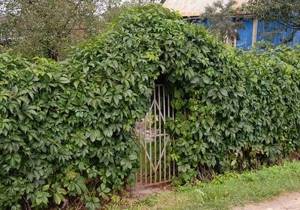
After planting, the crop is provided with strong support. The lashes grow quickly, so from the first days it is necessary to fix them on a trellis. The branches have not yet become coarse and can easily withstand landscape design experiments. If you don’t take care of this in advance, you will have to trim the wood starting next year.
During the growing season, three mandatory waterings are needed. In spring and autumn, 10 liters of water are poured under each bush. In hot summers, the norm is increased to two buckets per event. To minimize moisture evaporation during hot weather, farmers mulch the root circle with a thick layer of peat and sawdust. Twice a season they are fertilized with complex fertilizers.
Pruning vines is an essential element of caring for climbing plants. The procedures are carried out before the buds appear and after leaf fall. Old and damaged shoots are removed, the shape is corrected, and the remains of greenery and bunches are removed.
To prevent virgin grapes from freezing in winter in harsh climates, they need to be protected. In the first year of life, seedlings are not resistant to low temperatures, so they can die in open ground. In the fall, the root circle is mulched with a thick layer (at least 15 cm) of peat and sawdust, and the trunk is wrapped in burlap. After the snow appears, a high snowdrift is poured on top.
Formation
Have you thought about how to grow virgin grapes? It is worth paying special attention to the formation of culture. During the first year, mature virgin ivy will grow several meters in size. Therefore, to prevent the vine from entangling the entire dacha plot, timely shaping should be carried out. This will significantly increase the decorative qualities of the vine.
At first, we guide the young growing shoots along the support in such a way that the skeleton of the plant we need is formed. Over time, this young vine will become woody and can no longer be moved. Don’t be afraid to immediately remove shoots that are not growing in the direction you want. This will not harm the vine in any way.
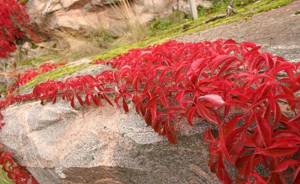
After the skeleton is fully formed, it is necessary to sanitize the plant. It is advisable to do this in the spring before the beginning of summer. During this procedure, all damaged, weak and too thick shoots are removed, which give the plant a sloppy appearance. If you notice that the crop is affected by a fungal disease, also remove the diseased vines to avoid the spread of infection throughout the bush.
The most popular varieties
Among the most popular varieties, two varieties of virgin grapes stand out, which are most often used for landscape decoration.
Virgin (five-leaf)
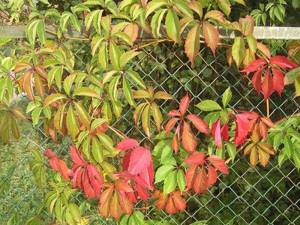
The five-leaf plant reaches a branch length of up to 20 m, is characterized by green foliage, acquiring a reddish tint closer to autumn. During the first year of life, young shoots grow up to 2.5 m, clinging to everything they can with their tendrils and suckers as they spread. The leaves look similar to chestnut greens. In July, the bushes begin to bloom abundantly; they are densely covered with inconspicuous small flowers of yellow-green color. Already in the first ten days of August, small clusters of dark blue berries can be seen on the branches of the vine, which often become a delicacy for birds.
The Virginia variety is distinguished by its unpretentiousness in care and the ability to actively develop even on devastated soils and in the shade.
Ivy-shaped (triacute)
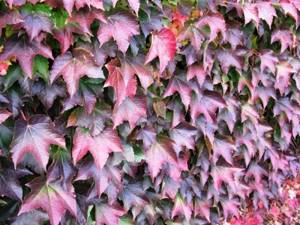
The variety received its name due to the similarity of the leaves with ivy greens. The culture is very widely used as decoration in Asian countries: Korea, China, Japan. The color of the leaves depends on the variety. The golden vine is characterized by the presence of yellow spots on the green surface, the purple subspecies has a dark burgundy coating, and the Vicha grape is distinguished by small glossy green leaves, which acquire a bright orange color in the fall. Thanks to its magical transformation and unique beauty, Vicha is in greatest demand among designers and gardeners.
Feeding and fertilizer
When figuring out how to grow virgin grapes, one cannot help but say a few words about proper feeding of the crop, as well as the application of fertilizers. During the first three years, most of the plant's energy is spent on developing the root system. In this regard, virgin ivy must be treated in the spring with a solution of nitroammophos (about 40-50 grams per 10 liters) or any other complex universal fertilizer. Then the plant does not need feeding. Rules for the care and planting of ornamental grapes include the application of fertilizers. However, this is not a mandatory procedure at all.
Plant care
Timely watering is necessary for grapes to grow rapidly. But in order for a well-groomed plant to grow on the site, it needs to be pruned.
Adviсe:
- Moderate watering of an adult plant 3-4 times a season, 10 liters of water per bush.
- Removing weeds and mulching with peat, humus or compost makes the soil fertile.
- In spring, remove dried tips of branches, damaged and weakened shoots.
- In late autumn or early spring, when the plant is “dormant,” formative pruning is carried out to a stump of no more than 0.5 cm.
- In the summer, as the grapes grow, they tie them up and install new supports, if necessary.
- To prevent the plant from creeping along the wall of the house onto the roof, install a barrier made of chain-link mesh.
- In frosty regions, a protective film cover is made for Virginia grapes.
Fertilizer application
After the appearance of the first shoots and during the period of rapid growth, nitroammophoska is added at the rate of 45 g per 1 m². The fertilizer is diluted in 10 liters of water. First, loosen the soil, then water the plant.
To stimulate the growth of green mass, grapes are fed with Kemira Universal. It is applied in the evening after sunset or early in the morning.
The soil is enriched with organic matter: humus, peat, two-year-old compost. It is also mulched with sawdust or rotted leaves.
Diseases and pests
In hot weather, mealybugs settle on leaf blades, but heavy rain washes away this parasite. In order not to wait for inclement weather and remove the pest, you need to spray the plant with a product prepared according to a folk recipe.
Recipes:
- Horsetail tincture: crush it, add hot water and leave for a day.
- Vegetable oil is added to water at the rate of 2 tbsp. l. for 1 l.
- Soap solution: 15 g of liquid soap per liter of water.
- Garlic tincture: 5 cloves are kept in half a liter of water for four hours.
They also use the drugs “Fitoverm” and “Fufanon”. And if the leaves of the grapes begin to curl, which happens due to a lack of microelements, they are fed with an infusion of wood ash.
By layering
With the onset of spring, it is necessary to select about five young lashes, each of which has several unopened buds. We dig them in several places into pre-prepared grooves, the depth of which should be at least 5 centimeters. The ends should be pinned to the ground with a special garden pin or wire. As a last resort, you can use a slingshot branch. We leave the end of the lash outside untouched. After this, all that remains is to thoroughly water such a seedling. In 3-4 months you will receive several full-fledged plants with a developed root system, which will be ready to be transplanted to a new location.
Cuttings
Cuttings can be carried out both in spring and autumn. To do this, you will need to choose a middle-aged whip, at least 3-4 years old, as thick as a pencil. We cut the vine into several pieces so that each cutting has at least one green cob. We tear off all the leaves. After this, all that remains is to plant the cuttings in fertile soil so that the buds remain on the surface. In order to speed up the process of formation of the root system, it is necessary to scratch the part that will be buried under the ground. If the cutting was planted in a sunny area, be sure to shade it as soon as the first shoot forms. After this, all that remains is to water it regularly in order to ensure good survival.
Features of care, preparation for winter
At first, it is necessary to regularly water the young shoot. An adult plant is moistened no more than 3-4 times per season. Its unpretentiousness to moisture is explained by the deep penetration of root shoots into the soil, where it consumes natural water reserves.
Regular care is required for the formation of the bush itself. The plant needs to be pruned, and also needs pruning, garters, and installation of supports to guide the weaving of branches. However, it is worth considering that only young seedlings need a garter when the tendrils have not yet developed enough to firmly attach to surfaces.
The first year of a seedling's life is characterized by rooting and the beginning of growth of the vine. The immune system is not sufficiently strengthened in such a short time, so gardeners advise covering young crops for the winter to prevent freezing.
To stimulate the development of branching parts and foliage, it is recommended to periodically (2-3 times per season) apply fertilizer to the soil. The simplest option is watering with a solution of wood ash. You can also use potassium magnesia, nitroammophoska, and aquamarine.
Maiden grapes tend to gradually rise in the soil and expose the rhizome. If you notice that the roots of the plant begin to protrude above the ground, be sure to add fresh soil and lightly hill up the vine. This procedure is usually carried out in the fall, as part of preparing the garden for winter.
Seeds
This method is considered quite troublesome. First you need to stock up on seed material. To do this, we wait for the grapes to rot, after which we carefully pick out the seeds from them. For better germination, they should be stratified with the onset of spring. To do this, the seed is soaked for several hours in ice water, after which it is placed in damp sand and placed in the refrigerator for about a month. After this, all that remains is to sow the seeds in the ground and wait for the first shoots, which will sprout in about three weeks.
Root suckers
Perhaps this method of reproduction is the simplest and most common. In places where the young vine comes into contact with the soil, aerial roots are formed over time, which can develop into a full-fledged system with proper care. All that is required of you is to plant them in a permanent place so that the root collar is not too deeply buried in the ground. After this, all that remains is to regularly water the young plant and make sure that the scorching sun does not burn all the leaves on it.

We hope our article helped you figure out how to plant girlish grapes. Follow the basic rules of caring for the crop, and over time you will have a huge hedge with amazing decorative qualities.
Advantages of girlish grapes
Wild grapes have invaluable advantages over their finicky counterparts. The beautiful carved leaves of the plant will beautifully decorate any place; it grows quickly, has winter-hardy properties, and is unpretentious to soil, watering and sun. It will be a good decoration for both the sunny side of the house and the gazebo in the back of the garden.
